chufa
Chufa
(Cyperus esculentus), also earth almond, ground almond, or rush nut; a perennial herb of the family Cyperaceae. During the first year of vegetation, chufa forms as many as 240 fascicles of leaves and 400 underground shoots with terminal tubers. A single plant may have as many as 1,000 tubers. There are three to 12 leaves in a fascicle. The sessile leaves are long (up to 80 cm) and narrow (5–10 mm). The small flowers are located in the axils of the upper leaves and gathered in umbellate inflorescences. The fruit is a nut.
Chufa is distributed in Egypt, Italy, and Spain, as well as in Asia Minor and in the countries of tropical and southern Africa. In the USSR it is found in Transcaucasia and the Volga Region. The main region of commercial production of chufa is Spain. In the USSR it is found in collection and experimental plantings.
Chufa is cultivated as an annual. The vegetative period is 110 to 120 days. The best soils are sandy loams, light loams, and chernozems; saline and waterlogged soils are unsuitable. Chufa is propagated by tubers or by seedlings. The yield of tubers is 20–30 quintals per hectare (ha) or, if irrigated, 40–50 quintals per ha. The tubers contain 30–35 percent starch, 15–20 percent sugar, 20–25 percent oil, and 3–7 percent protein. Chufa may be eaten raw, fried, or boiled. It is used in the production of confectioneries, beverages, coffee and cocoa substitutes, and cooking oil. The cut green mass can be fed to animals directly, or it can be ensiled.
